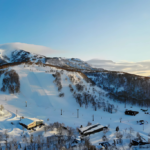If you’re a parent who grew up on the slopes, you’re probably sitting around impatiently waiting for the day when you can take junior out into the powder with you. Getting them out onto the hills, however, can be a bit of a nerve-wracking venture. Start too early, and the kids may have a negative experience that affects their perception of snow for years to come. Don’t make things the right amount of fun and they’ll see it less as an adventure and more as a slog.
So, how to do you make sure the kids are alright at the end of your ski trip (and asking when they can go again!)? Here we look at some practices you should implement when teaching your kids the fundamentals of skiing and the best ways to help them understand that the slopes are a fun and safe place to be.

How to Acclimate Your Child to the Slopes
To understand how to get kids acclimated to the slopes, we talked to Krista Coy, the Director of Niseko Kid’s Club. The Niseko Kid’s Club is a daycare program designed to instil an everlasting love for snow in children as young as a year old. Having worked with child therapists, psychologists, child yoga instructors, early childhood educators, and ski instructors to build their ever-changing programs to ensure children find joy in the snow, they really know what they’re talking about.
Read also: Something other than ski slopes: Niseko activities for the whole family
As Krista tells us, “there are a lot of factors that go into integrating children into snow and ski life. For a lot of the children coming [to Niseko], it’s their first time seeing snow, so we’re starting from the point that they don’t even know what snow is and suddenly they’re told to go down a hill with these weird boots and these sticks on their feet.
“If it’s their first time in the snow, their first time in the gear, and then they’re suddenly in a new place with new food, new friends and a new teacher, it’s pretty overwhelming… A lot of the reasons why children have break-downs during ski lessons is because they’re not comfortable and don’t know what’s going on.”
Becoming a life-long lover of snow isn’t even an issue of age. Just because a child is old enough to join a ski class or go out with you, doesn’t mean the time is right for them. It’s about parents or caretakers taking the time to help their kids get used to snow and what’s happening around them.
As for what Niseko Kid’s Club does to help with the transition (and what you can do too!), Krista says, “we introduce children to snow and all the basics of snow before they have to put skis on their feet or even go near a hill. We start with the basics of here is snow, here’s what it is, here’s the gear you have to wear and here’s why it’s fun. And that’s the most important part – making sure they have a positive experience from the beginning.”
Introduce Your Child to Snow in a Fun Way
“We’ll take the snow from outside and bring it inside,” says Krista, “and let it melt. We’ll let the kids watch it. Then we’ll bring the melted snow outside, and they can watch it from inside and see how it freezes.”
It’s a way of letting children know that snow is another form of water and not something scary.
As well, during time outside (and Niseko Kid’s Club allows children to choose how much time to be outdoors), “that’s when we let children figure out the textures of the snow and learn ‘if I slide like this, this is how far can I go’, which can be super exciting for them.”
Help them Build Confidence Using their Gear
Getting children to the point where they can ski is also about doing things like helping children get to know what their gear is. “We try to help children,” Krista explains, “who may not yet be familiar with their snow gear to have a more enjoyable experience by gaining independence in putting on their own snow gear. Sometimes this means taking 30-40 minutes on the first day to learn about their own gear.
“After a few days, the children learn their own routine and are able to gear up in a shorter amount of time, and our goal is to do that without anyone getting upset because of the discomfort of the process.
Make Sure They Are Socially and Physically Capable
The social skills we need as skiers and snowboarders to safely navigate our way down a mountain might seem basic to us, but they’re not for children. There isn’t an instinct for stopping at the side of a trail rather than in the middle of one, or for quickly moving away from a chairlift’s ramp after getting off. So, it might seem silly, but children need specific social skills to be safe and ready to hit the slopes.
“Once children are comfortable and get the basics of understanding snow,” Krista says, “we move onto physical movements that emulate skills that are necessary for skiing and snowboarding. Our program involves indoor and outdoor obstacle courses, constructive toys that help children understand balance, depth perception, social interaction and spatial awareness.”
As Krista puts it, “By integrating children, in a social atmosphere, and doing obstacle courses and other activities we can help them develop underlying skills that will translate to better safety on the slopes.”
It’s about working from the basics up! To ensure your little one is able and ready to get on the slopes and love it, you need to, either on your own or with the help of professional services – help them understand the snow and get them used to the gear and their surroundings.
Read also: The first-timers Niseko guide: 10 things to know when planning your ski trip
What to Consider When Taking Them Out on the Slopes
So, you’re confident that your child is acclimated and ready to spend a few hours on the bunny hills! To keep them happy and excited about skiing and not turning it into a chore (you don’t want them to become bored or feel like they’re being ‘taught’ and not playing), there are a few things to keep in mind!
Add incentives to make learning fun!

This might seem obvious, but treats can go a long way to making learning fun. It doesn’t have to be candy either. Tell your kids stories on the lifts, or if you see them getting bored, take time to get out of your bindings and explore the outskirts of the “magical forest” just on the edge of the slope.
When they’re tired, take them into the lodge for a hot chocolate or sit with them in front of a fire (no phones though!) as you warm up.
If you’re happy to give your kids candy or snacks – they’re also a pretty good way of encouraging kids to make good, wide turns.
Play games
Sitting on a chairlift can seem like an eternity to a child. To make sure it doesn’t get too dull (and put them off the fun stuff), play games with them. “i-Spy” is a great game to get them started, but we’re also all for you singing songs or pretending that you’re pirates on your way to discover new and distant lands.
Read also: Beyond the Slopes: 7 things to do in Niseko even if you’re not skiing
Practice Moving in Their Gear
This is more important for kids learning to ski than for those learning to snowboard, but it is a great idea to give them the chance to practice walking around in their boots before strapping into their bindings. Those clunky and stiff boots are not exactly easy or fun to move about it.
Try to get them running around in them (as best they can) or doing things like squatting down to pick up snow for a snowball fight!

Focus on turns
As for the actual skiing, focus on turns. Yes, stopping is an essential skill, but stopping isn’t what’s going to get them skiing.
Something that parents quite frequently get wrong when teaching their kids to ski is telling them that the way to start a turn is by having them put their weight on one ski. Turning actually happens from the feet, knees and hips, not from emphasising the downhill ski.
Get your kids to practice a wide, athletic stance and to shift their feet so that they’re on their ski or board edges.
A fun way to help kids initiate their turns is to play “follow the leader”. When playing, have your kid pick a favourite animal. When they’re turning, they can roar like a lion, bark like a dog, purr like a cat, or quack like a duck. It rewards them with a simple pleasure for skiing or boarding well.
Talk with the lift operators
Lift operators are always on the look-out for beginning riders. If you’re with a child who is just getting started, it’s a good idea to let the lift operator know. They can slow down the oncoming chair as you get on, and do similarly when it’s time to get off.
Note: If you’re heading to Japan, an easy way to say “my child is a beginner, can you please slow the lift” is “beginā desu kara, rifuto no supīdo o otoshite kudasai.”
Also, remember that something important for you to do is to lift kids by the armpits when they get on or off the chair – this helps reduce the likelihood of an accident.

Most importantly – make sure they’re appropriately dressed!
This seems obvious, but merely dressing correctly for the weather can make or break a trip. Make sure you have items such as neck warmers, thermal underwear, waterproof jacket and pants, hat or helmet, gloves or mittens, goggles, ski socks, and sunscreen.
And because it’s your child’s first time, they will be falling A LOT. Bring a backpack with extra gear, because when things like neck warmers and mittens get wet, children get cold (and miserable) very quickly!





